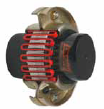The next information and facts is important when creating a Grid coupling selection:
Description of motor or engine, the horse power (or KW), and RPM at slowest coupling speed whilst below load
Description with the driven products
Shaft and keyway sizes and also the  kind of fit for driver and driven products (clearance or interference)**
kind of fit for driver and driven products (clearance or interference)**
Shaft separation (BSE)
Bodily space limitations (see Application Worksheet)
Decide what the environmental conditions will be, this kind of as temperature, corrosive ailments, interference from surrounding structures, and so on.
By default, sizes 1020 – 1090 will be clearance match, sizes 1100 – 1200 will be interference match.
** Machines all bores and keyways to meet the dimensional and tolerance specifications per ANSI/AGMA 9002-B04 for inch bores, or ISO 286-2 for metric bores.
Normal grid couplings include two grid hubs, a grid spring, and also a cover assembly. When the shaft separation necessitates a spacer design coupling, the coupling will include two shaft hubs, two spacer hubs, a grid spring, in addition to a horizontal cover assembly.
Formulas Used To Determine Torque:
Application Torque (in-lbs) = ( horse energy x 63025 ) /RPM
Application Torque (Nm) = ( horse electrical power x 9550 ) /RPM
Variety Torque = Application Torque x Service Factor
Substantial Peak Loads and Brake Applications
For applications exactly where high peak loads or substantial braking torques may be current, the following additional facts is going to be necessary:
Technique peak torque and frequency
Duty cycle
Brake torque rating
The variety torque formula is similar to the formula proven over except the application torque really should be doubled prior to applying the service factor.
Application Torque (in-lbs) = ( horse electrical power x 63025 ) /RPM
Application Torque (Nm) = ( horse power x 9550 ) /RPM
Selection Torque = two x Application Torque x Service Element
Methods In Picking A Grid Coupling
Phase one: Determine the application torque employing the formula proven over.
Phase two: Choose the Support Factor in the charts .
For applications not displayed utilize the chart proven for the right. Figure out the Choice Torque utilizing the formula shown above.
Phase 3: Working with the assortment torque as calculated, refer to your Overall performance Chart
Step 4: Compare the utmost bore for that dimension chosen and make sure the needed bore sizes tend not to exceed the maximum allowable. When the essential bore dimension is larger, stage up to the subsequent size coupling and test to discover in the event the bore sizes will match.
Step 5: Using the chosen coupling size, evaluate the bore and keyway sizes
Step six: Make contact with your area industrial supplier using the aspect numbers to spot sizes with all the charts for UPC aspect numbers.